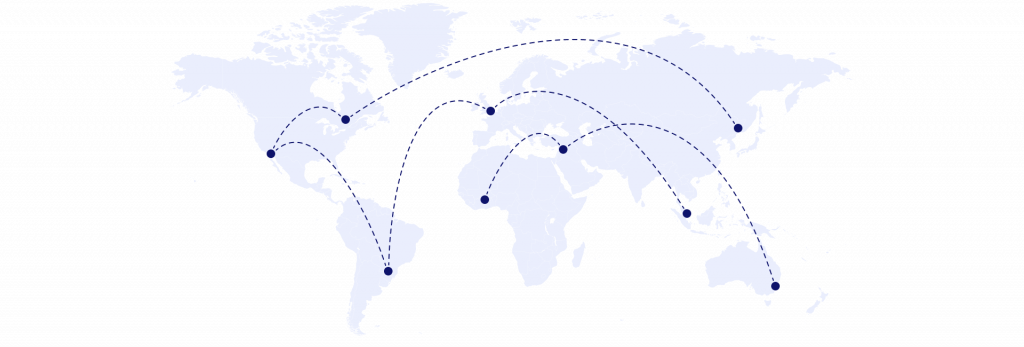Here's the how and why of diversifying your supply chain
In today’s global business landscape, expanding your supplier base can bring a range of benefits. However, supply chain diversification also comes with risks. This guide explores the upsides and downsides, as well as creative ways to find new suppliers and build a reliable and resilient supply chain.

As a business owner, entrepreneur, or ecommerce seller, you know how important it is to maintain a reliable supply chain. But what happens when that chain is disrupted? Here’s why diversifying your supply chain is essential for business success.
Benefits of increasing supplier diversity
Diversifying your supply chain means working with multiple suppliers, rather than relying on a single source. This has a number of benefits.
- Reduced risk: Lower the chance of disruptions from things like natural disasters, political issues, or supply chain problems. This improve your supply chain resilience.
- Increased flexibility: Working with multiple suppliers gives you greater flexibility to adjust to changes in demand, quality, or pricing.
- Cost savings: You can negotiate better pricing and terms with multiple suppliers, which can help you save costs.
- Competitive advantage: You may gain a competitive advantage by providing access to new markets, products, or technologies.
- Open 15+ local currency accounts and get paid like a local
- Pay suppliers, partners and staff worldwide in 100+ currencies
- Collect payments for free from 130+ marketplaces and payment gateways, including Amazon, Etsy, PayPal and Shopify
- Take control of spending with the World Card, a business expense card that saves you more with 1% cashback. Learn more
- Save with competitive exchange rates on currency conversions and transfers
- Lock in exchange rates for up to 24 months for cash flow certainty
Risks of expanding your sourcing channels
While increasing your supplier base can bring many benefits, there are also risks to consider. These include:
- Increased complexity: Working with multiple suppliers can increase the complexity of managing your supply chain and require additional resources and expertise.
- Quality control: When you’re managing multiple suppliers, it can become more difficult to maintain consistent quality standards across your products.
- Communication challenges: Working with multiple suppliers, especially those in different countries or time zones, can make communication more difficult. There might be language barriers and delays in response due to the time difference.
- Cost: Diversifying your supply chain could end up increasing costs. You may need to invest in additional technology, staff, or resources to manage multiple suppliers.
How to minimise the risks
Establishing robust procedures and systems is necessary for businesses to manage a complex supply chain with multiple suppliers. This includes in areas such as communication, inventory management, quality control, logistics, and compliance. It could mean that you implement technology solutions, such as supply chain management software, and establishing clear protocols and guidelines for supplier relationships. It may also involve investing in training and development programs for staff to build expertise in supply chain management.
To minimise the risks associated with new suppliers, there are several tactics you can employ:
Develop a clear sourcing strategy: Consider your business goals, budget, and quality standards before searching for new suppliers.
Vet suppliers thoroughly: Thoroughly qualify suppliers before signing a contract to ensure they meet your quality, reliability, and compliance standards. Platforms such as Alibaba.com offer Trade Assurance for peace of mind. Meanwhile, 1688.com, China’s largest B2B marketplace, shows supplier information, including years in operation, response rate, return rate, and transaction history over the past 90 days.
Build strong relationships: Building strong relationships with suppliers can help minimise the risks associated with communication challenges, quality control, and cost.
Use technology: Technology can simplify a diversified supply chain by automating data collection and analysis, while also providing real-time visibility into supplier performance. Supply Chain Management (SCM) software for example, tracks inventory, manages supplier relationships and optimises logistics. Some popular examples include SAP, Oracle, and Microsoft Dynamics. You should ensure these technology solutions integrate with existing systems and can be easy for staff to use.
How to diversify your supply chain
To effectively diversify your supply chain, consider the following:
Identify the need for diversification: Assess recent and potential future changes in demand, supply chain disruptions, or strategic goals for growth. It could be that your business is not yet at the stage where you need multiple suppliers and the costs and risks outweigh the benefits.
Develop a sourcing strategy: Develop a strategy that identifies potential new suppliers and evaluates whether they are suitable. How do these new suppliers stack up against your existing ones? What benefits can they offer you that are currently lacking in your existing suppliers?
Select your suppliers: Vet suppliers by considering their financial stability, quality control processes, production capacity and compliance with regulations. Cultural fit and communication skills should also be considered, as these could make or break a relationship. For example, if you require a response to communications within 24 hours and your supplier thinks a three-day response rate is adequate, it’s important to align on expectations. It’s better to be upfront, rather than wait for issues to arise.
Build supplier relationships: Good communication, frequent visits and cooperation can foster strong supplier relationships.
Measure supplier performance: Don’t forget to regularly track key performance indicators (KPIs) such as on-time delivery, quality, and cost.
Continuously improve: Evaluate the effectiveness of your sourcing strategy, supplier performance, and supply chain processes on an ongoing basis. This can help identify areas for improvement and drive long-term success.
Creative ways to find suppliers
To find new suppliers, consider these creative tactics:
Attend trade shows and conferences: Attend industry events to meet potential suppliers, learn about new products, and expand your network.
Referrals: Ask for referrals from industry colleagues, customers, or suppliers. Word-of-mouth recommendations can be a valuable source of information about potential suppliers.
Online marketplaces: Online B2B marketplaces can provide access to a large number of suppliers from around the world.
Social media: Use LinkedIn, Twitter, or Facebook to search and connect with industry groups and other professionals.
As global business becomes the norm, varying your supply chain partners is increasingly important for success. Despite some risks, diversification offers benefits such as flexibility, cost savings, and a competitive edge. With a solid plan and creative supplier sourcing, you can build a strong supply chain to support your business.
Disclaimer: These comments are the views and opinions of the author and should not be construed as advice. You should act using your own information and judgement. Whilst information has been obtained from and is based upon multiple sources the author believes to be reliable, we do not guarantee its accuracy and it may be incomplete or condensed. All opinions and estimates constitute the author’s own judgement as of the date of the briefing and are subject to change without notice. Please consider FX derivatives are high risk, provide volatile returns and do not guarantee profits.


Mexico e-commerce market: your next growth opportunity | WorldFirst
Mexico offers huge potential to grow your business – especially if you can make and receive payments easily. Here’s what you need to know about expanding your business to Mexico.
Mar / 2024
Poland’s tech hubs driving business growth | WorldFirst
Discover how Warsaw and Krakow are driving business growth in Poland. Learn about their innovative tech scenes and opportunities for expansion.
Feb / 2024
Increase sales with the new Polish zloty (PLN) local account | WorldFirst
Discover why you should be doing business with Poland and how easy it is to pay and get paid in the local currency, Polish Zloty
Jan / 2024Choose a category below for more business, finance and foreign exchange support from WorldFirst.
- Almost 1,000,000 businesses have sent USD$300B around the world with WorldFirst and its partner brands since 2004
- Your money is safeguarded with leading financial institutions































































